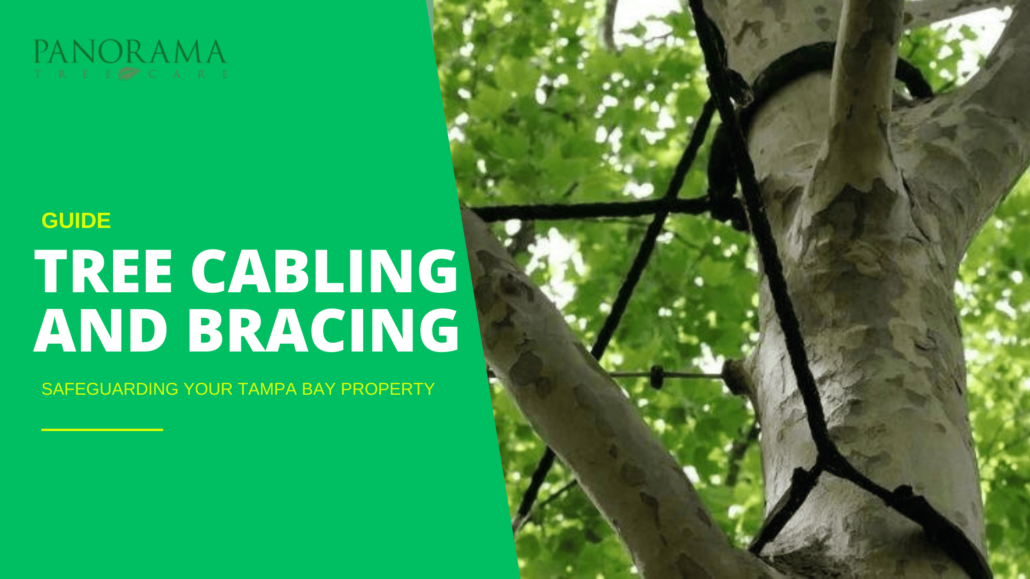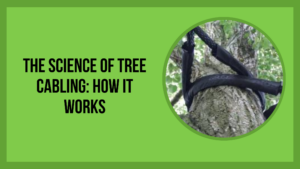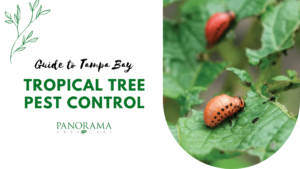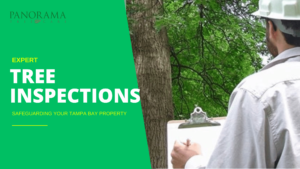Tree cabling and bracing are crucial techniques for preserving the health and stability of trees. At Panorama Tree Care, we specialize in providing these essential services to ensure your trees remain safe and healthy.
These methods help support trees with structural issues, ensuring they remain safe and healthy for years to come.
Understanding Tree Structural Issues
Common Causes of Tree Instability
Trees can become unstable for a variety of reasons, and understanding these can help prevent potential hazards. Here are some of the common causes:
1. Environmental Factors
- High Winds: Strong winds can cause branches to sway excessively, which may lead to cracks or splits in the branches or trunk.
- Heavy Snow and Ice: Accumulation of snow and ice can add significant weight to branches, causing them to break or split. This is particularly problematic for trees with dense foliage or weak branches.
2. Growth Patterns
- Co-Dominant Stems: This occurs when a tree has two or more main stems growing close together at the same height. These stems can create a weak point where they join, making the tree more susceptible to splitting.
- Improper Pruning: Incorrect pruning techniques can lead to unbalanced growth, which might cause some branches to become too heavy and prone to breaking.
3. Root Issues
- Root Damage: Construction activities, such as digging or trenching near trees, can damage roots. Damaged roots weaken the tree’s anchor to the ground, making it more likely to topple in strong winds.
- Root Rot: Fungal diseases can cause root rot, which deteriorates the tree’s root system. A weakened root system can’t support the tree’s weight, leading to instability.
4. Diseases and Pests
- Disease: Certain tree diseases can weaken branches and trunks. For example, canker diseases can cause areas of dead bark and underlying wood, leading to structural weaknesses.
- Pests: Insects like borers can create tunnels in the wood, weakening branches and trunks from the inside.
Signs That a Tree May Need Cabling or Bracing
To ensure your trees remain healthy and stable, it’s important to recognize the signs indicating they may need additional support. Here are some key indicators:
1. Physical Signs of Stress
- Leaning Trunks: A noticeable lean in the trunk of the tree can indicate that the tree’s roots are not providing adequate support, or that the tree is experiencing uneven weight distribution.
- Cracked Branches: Visible cracks in branches or the trunk suggest structural weaknesses that could lead to branch failure.
2. Unusual Growth Patterns
- Co-Dominant Stems: If you notice two or more main stems growing close together, the tree might benefit from cabling to support these stems and prevent them from splitting.
- Heavy Limbs: Large branches that appear too heavy or are drooping significantly may require support to prevent them from breaking off.
3. Damage Indicators
- Splitting at the Trunk: Splits where the trunk divides into major branches (the crotch) are a sign that the tree is experiencing significant structural stress.
- Loose or Exposed Roots: Signs of root movement or exposed roots at the base of the tree indicate potential instability, especially after heavy rains or high winds.
4. Canopy Imbalance
- Unbalanced Canopy: An uneven canopy can lead to weight being distributed unevenly, putting extra stress on certain branches. This can be a result of improper pruning, storm damage, or natural growth patterns.
What is Tree Cabling?
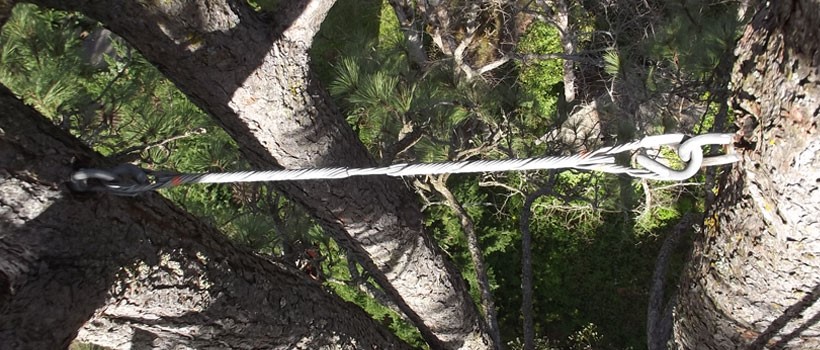
Tree cabling involves installing flexible steel cables between branches to reduce stress on weak points. This method helps redistribute the weight of limbs and support trees against strong winds or heavy foliage.
Materials Used in Cabling
Cabling typically uses high-strength steel cables and bolts. These materials are durable and flexible, allowing trees to move naturally while providing necessary support.
Types of Cabling Systems
There are two main types of cabling systems: static cabling, which uses rigid cables to limit movement, and dynamic cabling, which uses flexible materials to allow more natural movement while providing support.
What is Tree Bracing?
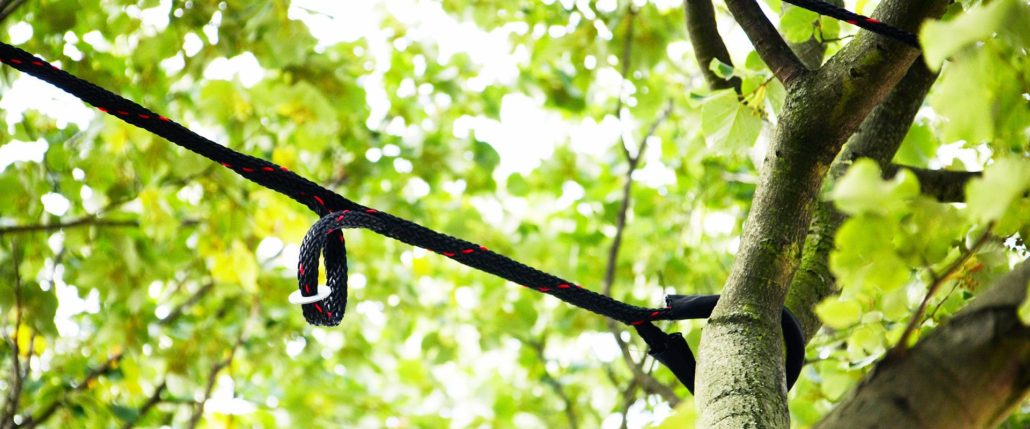
Tree bracing involves installing rods and braces inside the tree to support and stabilize weak or split branches. This technique is often used when cabling alone isn’t sufficient.
Materials Used in Bracing
Bracing uses threaded steel rods, braces, and bolts. These materials are inserted into the tree to hold weak points together, preventing further splitting or cracking.
Different Bracing Techniques
Techniques include threaded rods, which run through the tree, and brace rods, which are installed perpendicular to the split to hold it together.
When to Use Cabling vs. Bracing
Scenarios Suitable for Cabling
Cabling is a technique used to add supplemental support to trees with structural weaknesses, particularly in the branches. For trees showing signs of structural weakness or for preventative support, it’s best to opt for professional tree cabling and bracing services.
Our expert tree cabling services Tampa are ideal for mitigating structural weaknesses, offering long-term support through professionally installed, weather-resilient systems.
Our certified arborists use the latest techniques to provide optimal support and longevity for your trees.
Here are some common scenarios where cabling is most effective:
1. Heavy or Overextended Branches
Branches that have grown too large or extended too far from the trunk can become heavy and prone to breaking, especially during storms or under the weight of snow and ice.
Cabling helps by redistributing the weight and reducing the stress on these vulnerable branches.
2. Co-Dominant Stems
When a tree has two or more main stems (trunks) growing from the same point, it creates a weak junction, making the tree more susceptible to splitting.
Cabling is used to provide additional support to these stems, helping them withstand environmental stresses and preventing them from separating.
3. Preventative Support
In some cases, trees may not yet show visible signs of weakness, but an arborist might recommend cabling as a preventative measure.
This is particularly common in trees with a history of limb failure or in species known to develop weak branch unions.
Situations Where Bracing is Preferred
Bracing involves the use of rigid rods and braces to provide more substantial support to trees with significant structural issues. Here are situations where bracing is the preferred method:
1. Severe Splits or Cracks
When a tree has developed severe splits or cracks, particularly in the trunk or major branches, bracing provides the necessary strength to hold the damaged parts together.
This technique prevents further splitting and helps the tree heal over time.
2. Weak Branch Unions
In cases where branches are weakly attached to the trunk, bracing can be used to reinforce these unions.
This is particularly important for large, mature trees where the failure of a major branch could result in significant damage.
3. Structural Restoration
For trees that have suffered significant damage from storms, pests, or disease, bracing can help restore structural integrity.
By installing braces, the tree is given a chance to recover and continue growing without the immediate risk of limb failure.
Combining Cabling and Bracing for Optimal Support
In many cases, the best approach to supporting a tree involves a combination of both cabling and bracing.
This integrated method provides comprehensive support and ensures the tree’s stability in various conditions. Here’s how combining these techniques can be beneficial:
1. Comprehensive Support for Large Trees
Large, mature trees often have multiple structural issues that cannot be addressed by a single method.
Combining cabling and bracing provides the necessary support to different parts of the tree, ensuring overall stability and reducing the risk of failure.
2. Enhanced Flexibility and Strength
While cabling offers flexibility, allowing branches to move naturally in the wind, bracing provides rigid support where it’s most needed.
By using both methods, the tree can maintain some natural movement while still being protected from structural failure.
3. Long-Term Health and Preservation
Combining cabling and bracing helps in preserving the tree’s health and extending its lifespan.
By addressing both immediate and potential future structural issues, this approach ensures that the tree remains stable and healthy for many years.
Practical Examples
Example 1: A Large Oak Tree with Co-Dominant Stems
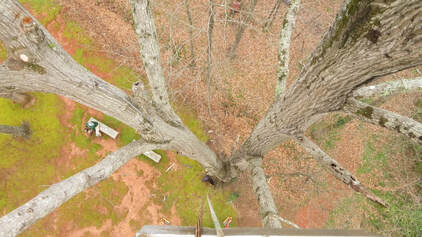
A large oak tree with two main stems is showing signs of stress at the union. An arborist decides to install cables between the two stems to reduce movement and stress.
Additionally, they place a brace through the union to prevent it from splitting further.
Example 2: A Maple Tree with Heavy Branches and a Split Trunk
A maple tree has several heavy branches that are starting to droop and a noticeable split in the trunk. The arborist installs cables to support the heavy branches and prevent them from breaking.
They also use bracing to stabilize the split trunk, ensuring that it holds together and heals over time.
The Process of Installing Cables and Braces
Assessment and Planning
The first step in the process of installing cables and braces is a thorough assessment by a certified arborist.
This professional evaluation is crucial to identify the specific structural issues and determine the best course of action. Here’s how it typically works:
1. Visual Inspection
The arborist conducts a detailed visual inspection of the tree, looking for signs of structural weakness such as:
- Leaning Trunks: This indicates potential root instability or uneven weight distribution.
- Cracked or Splitting Branches: These are clear signs of stress that need immediate attention.
- Weak Branch Unions: Especially in cases of co-dominant stems or poorly attached branches.
- Overextended or Heavy Limbs: Branches that are too long or heavy, posing a risk of breaking.
2. Risk Assessment
The arborist evaluates the potential risks associated with the tree’s condition. This includes:
- Proximity to Property and People: Assessing the likelihood of branches falling on houses, cars, or walkways.
- Environmental Factors: Considering local weather conditions, such as high winds or heavy snow, that could exacerbate the tree’s instability.
3. Plan Development
Based on the inspection and risk assessment, the arborist develops a detailed plan for installing cables and braces. This plan includes:
- Identifying Key Points for Support: Determining the exact locations where cables and braces will be most effective.
- Selecting Appropriate Materials: Choosing the right type and size of cables, braces, and hardware to ensure maximum effectiveness and minimal damage to the tree.
- Safety Measures: Ensuring that the installation process will be conducted safely, both for the arborist and the tree.
Installation Techniques
Once the assessment and planning are complete, the installation process begins. This involves several key steps:
1. Preparing the Tree
- Clearing the Area: Ensuring that the work area around the tree is clear of obstacles and safe for the arborist.
- Accessing the Canopy: Using climbing gear or a lift to reach the necessary height in the tree’s canopy.
2. Drilling Holes
- Choosing the Right Locations: Based on the assessment, the arborist drills holes in strategic locations on the tree.
- Precision Drilling: Care is taken to drill the holes at the correct angles and depths to avoid further damage and ensure a secure fit for the hardware.
3. Inserting Hardware
- Installing Eye Bolts or Thimbles: These are inserted into the drilled holes to provide attachment points for the cables or braces.
- Attaching Cables: High-strength steel cables are attached to the eye bolts. The cables are then tensioned to provide the necessary support without restricting the tree’s natural movement.
- Installing Braces: For bracing, threaded rods are inserted through the trunk or branches, with washers and nuts securing them in place. This rigid support helps hold split or cracked sections together.
4. Securing the System
- Double-Checking Connections: All connections are double-checked to ensure they are secure and properly tensioned.
- Adjustments: Initial adjustments are made to ensure that the support system is functioning correctly and that there is no undue stress on any part of the tree.
Post-Installation Care and Monitoring
After the installation, regular care and monitoring are essential to ensure the long-term effectiveness of the cables and braces. This involves:
1. Regular Inspections
- Scheduled Check-Ups: The tree should be inspected periodically, typically once a year, by a certified arborist to ensure that the support systems are intact and functioning correctly.
- Storm Aftermath Inspections: After major storms or heavy snowfalls, additional inspections may be necessary to check for any damage or changes in the tree’s condition.
2. Monitoring Tree Growth
- Adjustments for Growth: As the tree grows, the cables and braces may need to be adjusted to accommodate new growth and ensure that they are not constricting the tree.
- Checking for Hardware Wear: Over time, hardware can wear out or become damaged. Regular inspections help identify any issues early, allowing for timely replacements or adjustments.
3. Addressing New Issues
- New Structural Weaknesses: Trees continue to grow and change, potentially developing new structural weaknesses that need to be addressed with additional cabling or bracing.
- Health Monitoring: Regular monitoring also involves checking the overall health of the tree, including looking for signs of disease or pest infestations that could impact its structural integrity.
Benefits of Professional Tree Cabling and Bracing
Extending Tree Lifespan
Proper support can significantly extend the life of a tree, allowing it to thrive for many more years.
Protecting Property and People
Supporting unstable trees helps prevent branches from falling, protecting nearby property and people.
Preserving Landscape Aesthetics
Healthy, well-supported trees enhance the beauty of your landscape, adding value and appeal to your property.
Maintenance and Inspection of Cabled and Braced Trees
Importance of Regular Check-Ups
Regular inspections ensure that the support systems remain effective and identify any new issues early on.
Signs That Adjustments May Be Needed
Look for signs like cables or braces becoming loose, tree growth affecting the hardware, or new splits developing.
Longevity of Cabling and Bracing Systems
With proper maintenance, cabling and bracing systems can last for many years, providing long-term support and stability.
Tree Cabling and Bracing in Tampa Bay
Local Environmental Factors Affecting Tree Stability
Tampa Bay’s weather, including hurricanes and tropical storms, can stress trees. The high humidity and frequent rains also contribute to root and structural issues.
How Panorama Tree Care Addresses These Challenges
At Panorama Tree Care, we understand the unique challenges of Tampa Bay’s environment. Our certified arborists use advanced techniques and materials to ensure your trees remain stable and healthy, even in harsh conditions.
When it comes to protecting trees in Florida’s extreme weather, trust the tree cabling experts in Tampa to assess, stabilize, and preserve your valuable trees with precision and care.
DIY vs. Professional Tree Cabling and Bracing
Risks of DIY Attempts
Improper installation can harm your tree and increase the risk of branch failure. It’s best to leave this task to professionals with the right expertise and equipment.
Benefits of Hiring Certified Arborists
Certified arborists have the knowledge and experience to assess tree health accurately and install support systems effectively, ensuring the best outcomes for your trees.
Cost Considerations
Factors Affecting the Price of Cabling and Bracing
Costs vary based on tree size, the extent of structural issues, and the materials used. An arborist can provide a detailed estimate based on these factors.
Long-Term Value of Tree Preservation
Investing in tree cabling and bracing can save money in the long run by preventing property damage and avoiding the costs of tree removal and replacement.
Conclusion
Tree cabling and bracing are essential solutions for protecting the health, safety, and longevity of structurally compromised trees. In Tampa Bay, where storms and high winds are common, securing your trees properly can make all the difference.
At Panorama Tree Care, our certified arborists specialize in advanced support systems that help trees thrive while preventing property damage.
Contact us today to schedule a professional assessment and safeguard your trees with expert cabling and bracing services you can trust.
FAQs
Common Questions About Tree Cabling and Bracing
Q: How long do cables and braces last? A: With proper maintenance, they can last many years, but regular inspections are crucial.
Q: Can cabling and bracing save a dying tree? A: These techniques support structural issues but cannot revive a dying tree. Other health measures may be needed.
Specific Concerns for Tampa Bay Area Trees
Q: How does the local weather affect tree stability? A: High winds and heavy rains common in Tampa Bay can stress trees, making cabling and bracing even more critical.
Q: Is there a best time of year for cabling and bracing? A: While it can be done any time, cooler months may reduce stress on the tree during the process.

